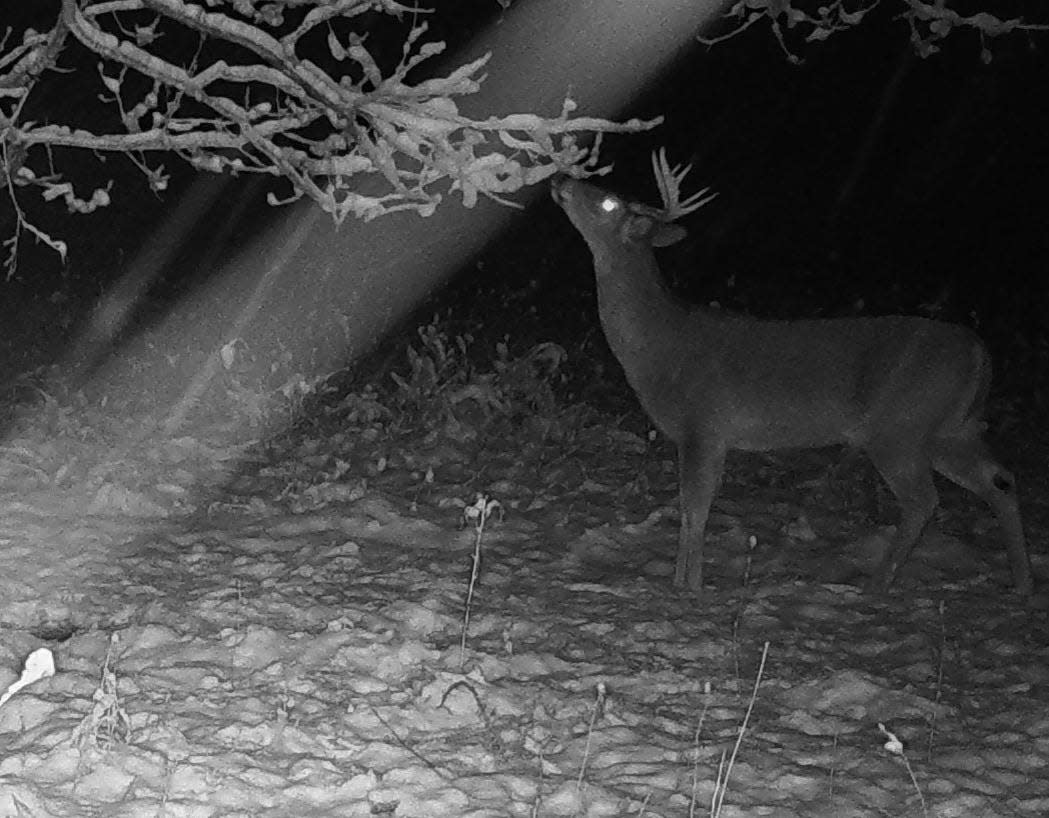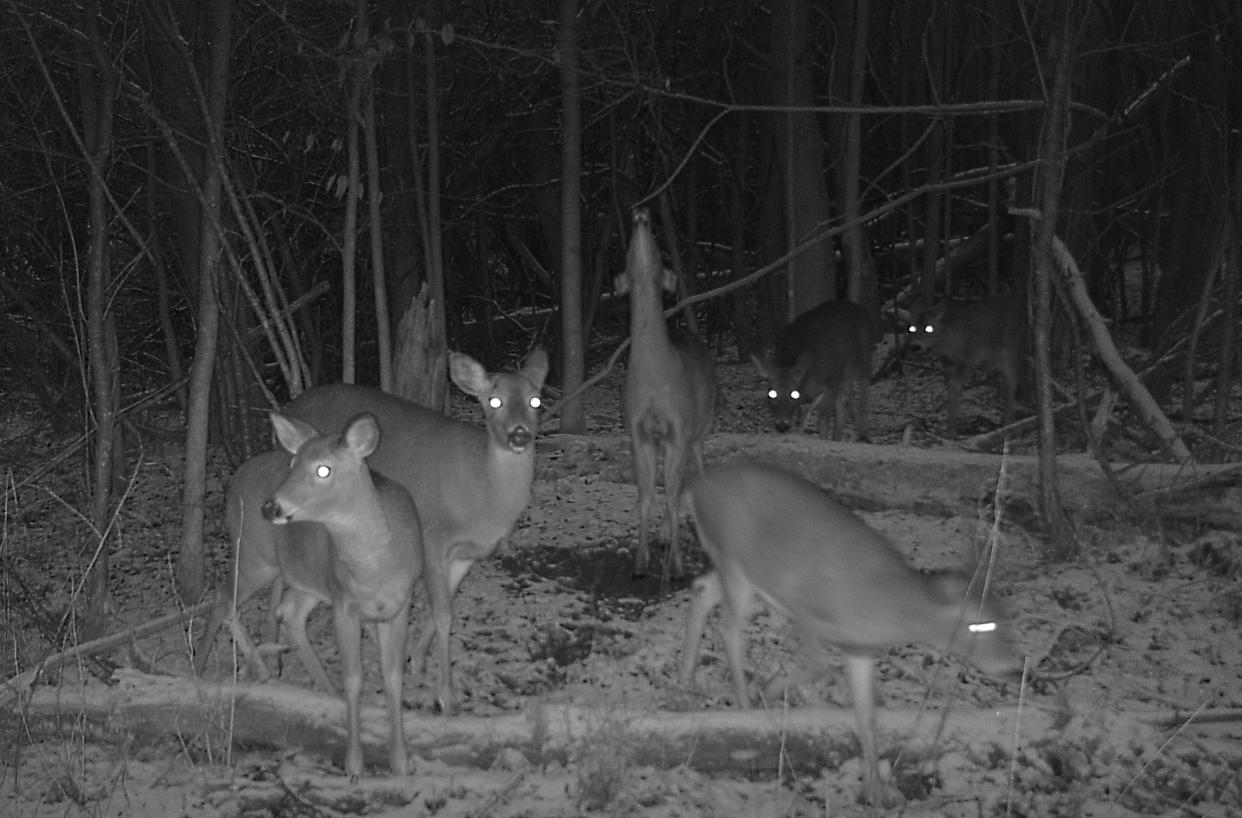Lessons learned from half a century of scrape hunting, now aided by trail cameras
Off and on for over 50 years, I have been killing bucks over scrapes.
But, beyond the hunting season, my obsession, fascination, and determination to plumb the mystery and meaning has not waned.
Trail cameras, now numbering about 20, record whitetail behavior at their scrapes on a number of different properties.
It’s actually embarrassing to see how wrong and misleading so many articles and opinions were about whitetail behavior before we had that window into their world … the trail camera.
We now have terabytes of video and photos of wild whitetails (as opposed to research animals in pens or enclosures).
Now the average hunter can see and learn what is going on in the deer woods, instead of taking as dogma the opinions of so-called experts.
These videos and stills added to my library that was started in the late 1970s, with my first telephoto lens. Sometimes grudgingly, once in a while like a bolt of lightning, they yielded insights that contradict what was considered gospel of the bygone years.
I launched an experiment 10 years ago to see if it was possible to create an Alpha scrape, one that would be freshened over and over again on a daily and nightly basis throughout the entire span of the rut and beyond.
Two of the four initial experimental sites exceeded my expectations. The two others were quickly cannibalized (moved their overhanging branches) to augment the two good ones.

That year’s September's full moon nearly coincided with the Autumnal Equinox (Sept. 19 this year). The main rut peaks were timed to occur midway through each of the succeeding two months.
Ironically, because this year, the moon will be full at nearly the same time (Sept. 17, 2024) and the rut’s timetable will be nearly the same.
Nonetheless, in mid-October, as scrape visitations ramped up, I collected a bouquet of field-scrape overhanging branches from other locations, miles away, and zip-tied them to a branch where there was not a scrape, only a smoking hot fresh rub, and set up a camera.
I repeated the process at two other locations, swapping field scrape overhanging branches randomly from location to location.
The premise was that I would introduce to the resident whitetails at each location, zip-tying a small bundle of overhanging branches, complete with saliva from other unknown deer, hoping to cause an explosion of deer activity there.
I was not disappointed, on the contrary, amazed at the number of bucks and doe that were brought in, and all recorded. I did not use any urine-based, or attraction lures other than cotton swabs saturated with saliva, taken during the previous season from the mouths of bucks and doe I had killed.
These cotton swabs were judiciously utilized, as once the scrapes became Alpha (determined by the multitude of visits) more saliva on the overhanging branches would only be redundant.
I was surprised to see the number of doe that visited the scrapes in proportion to bucks, as common scrape lore back in the day had it that scrapes were "a buck thing."
However, trail cameras don't lie.
Actually, there is almost a one-to-one ratio of doe to buck visits at these scrapes. Both bucks and doe lick the overhanging branch, and rarely, maybe 10% of the time, actually smell the ground by putting their heads down.

Where I hunt in Western New York, we possess a superb deer density, about five bucks per square mile according to the New York state DEC.
But at my two best Alpha scrape sites I recorded 27 and 17 different bucks, most on multiple occasions around the first rut peak in late October. (Two bucks might have very similar antlers in a photo, so I erred on the side of caution and didn't log it as a unique buck.) I think this shows that bucks will travel a long way to reach an Alpha scrape site. They know no boundaries.
Doe saliva at the scrape is as important as buck saliva, as both sexes exchange pheromones and biochemical messages there, all enabling the rut to synchronize and unfold. I had many doe show up, but few could be chronicled as repeat visitors unless they had unique markings.
Antler configurations, of course, differentiate bucks.
Action was hottest at the scrapes beginning in mid-October 2013 and again in mid-November, peaking just prior to Thanksgiving.
The actual daytime rutting appeared to be most active in late October, around Halloween, spilling into the first couple days of November. But of course the Regular firearms season was underway and tends to make deer more nocturnal.
More: Whitetail rut prediction for 2024: What to expect while deer hunting this fall
Nighttime and even some daytime action continued at the scrapes, even during the opening week of the New York state gun season, but as expected "we lost a lot of soldiers."
One of the bucks on my "buck-et list" was at my prime Alpha scrape site (where I recorded 27 different bucks) on the Opening Day of the New York rifle season at 8 a.m., a big high and wide seven-point. I have a tree stand 20 yards away. I got his picture.
But unfortunately, I was in a tree stand 10 miles away at another Alpha scrape site.
You still have to be lucky to get a big buck, no matter how much deer research is recorded.
— Oak Duke writes a weekly column.
This article originally appeared on The Evening Tribune: What scrapes can teach deer hunters about the rut, buck to doe ratios
